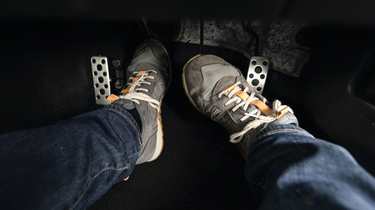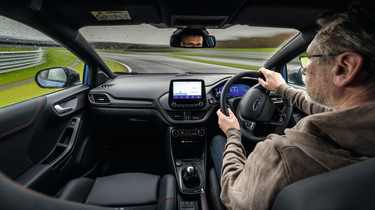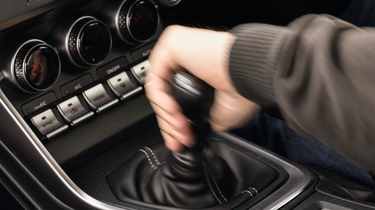Operating the controls: driving masterclass
How you interact with your car can play a significant role in unlocking its full potential, as Paul Ripley explains
Every turn of the wheel, every press of a pedal, every shift of the gearlever is an opportunity to refine your driving skills. By mastering the fundamentals of steering, braking, throttle control and gearshifting, you can elevate your driving experience to new heights. So in this page, we’re exploring the techniques that will improve the quality of your inputs and help you get the best possible responses from your car.
> How to overtake safely: driving masterclass
Steering
Steering is one of the most underrated yet difficult skills to master and one that becomes more important as speed increases. Drivers should develop a flexible approach to steering techniques and consider deploying different skill sets for different situations. Flexibility is key for drivers who practise fast road driving or partake in circuit driving and is essential when developing extreme car control techniques or learning the rudiments of skid control or ice driving.
An important element is the way we hold the steering wheel. The 10-to-2 hand position on the wheel is flawed because on long journeys it creates shoulder tension which induces fatigue. This position can lead to a driver resting their right elbow on the window ledge, thus losing the ability to quickly steer downwards with their right hand in the event of an incident demanding immediate steering action.
I advocate the quarter-to-three position. It’s more relaxed and less tiring for the hands, and the steering wheel’s spars can be used to advantage. The driver can make a ring with their index finger and thumb around the steering wheel rim, so the wheel is held delicately as the other fingers act as a guide when holding and turning the wheel.
The three main holding and turning techniques that I use are:
- Pull and Push – It may be old fashioned and difficult to master, but it still has a place in high-performance driving if performed correctly, i.e. if the driver utilises the fullest circumference of the wheel when turning, rather than the ‘shuffling’ technique we often witness. In certain situations where the wheel has to be turned very quickly, this technique doesn’t work, which is why people revert to our next technique…
- Rotational ‘cross hands’ steering – This skill is most useful when really quick steering is required, say when a driver is practising extreme car control or driving on a skid or ice driving facility, where the pull and push technique is simply not fast enough to control the car. One hand over the other applies the amount of lock quickly needed. The trick is to remember to unwind the same amount of lock to find centre again.
- Fixed input steering – This is where the driver uses a ‘fixed hand position’ on the wheel with both hands (9 and 3). It works superbly well when deployed in fast but shallow corners on the road and when circuit driving, as it ensures both hands share the inputs on the wheel in a balanced, smooth manner.
Whichever technique is used, it’s essential that the wheel is turned in a fluent, efficient manner that doesn’t disrupt the balance of the car or unsettle its grip, so that the car turns into a bend or junction smoothly.
Braking
Drivers can easily develop smooth, progressive braking skills by starting to lose speed slightly earlier and more gently than they might normally. This creates a heightened control of the car’s initial weight transfer onto the front suspension and tyres, making that transfer more progressive and less disruptive of the car’s moving mass and inertia. In effect, it makes the car more stable during braking.
Let’s also talk about ‘modulation’ of the brake pedal. This is the manipulation of your pressure on the pedal so you are able to slightly increase or decrease the braking effect during any braking manoeuvre. This skill can be practised every time you come to a stop by slightly releasing the pressure on the brake pedal so that the car comes to a stop without a jerk. Such sensitivity is essential when making serious progress (say when circuit driving) so that the braking inputs work in total harmony with the car’s weight transfer, caressing the moving mass and creating a flowing transition.
> Driving masterclass: how to be a safer and better driver
Throttle
Drivers seldom think about smoothness when accelerating or decelerating but it’s a great skill to master through some diligent practice because, as with braking, your passengers certainly will notice if your inputs are abrupt. Throttle control can be used to lose unwanted speed, balance the car’s weight and inertia when turning and mitigate understeer.
A driver who is scanning the road scene correctly and spotting a hazard early can lift the throttle rather than using the brakes to lose speed. It’s a great test of observation and planning. Test yourself by driving a challenging back road without braking for a mile or two. (But if you need to brake then do so – never compromise safety when learning new skills.)
Developing a delicate approach with your right foot on the pedals is a valuable skill. You can also use the throttle to balance the car’s handling, to stabilise it when driving quickly, by applying slight throttle just prior to turning into a corner and through it.
Changing gear
The fluidity of the drive is enhanced when the clutch is disengaged and re-engaged smoothly but, preferably, not onto a ‘dead engine’, i.e. one on tick-over. High-performance exponents often use a blip of the throttle (heel and toe when also applying the brakes) or ‘sustain’ the revs through using the throttle. Both techniques are worth developing.
Snatchy gearchanging is not the mark of a good driver, so slow down the whole motion of moving the gearstick from one position to the next: ‘feel’ the gear into position, rather than forcing it. Positioning your hand on the lever so that the natural movement is in the direction of the next gear helps this. It’s also an excellent habit to get into for circuit driving, lessening the chance of mis-shifts.
Transitions
To drive with real finesse it’s important to understand the sheer delicacy necessary when transitioning from one pedal to another; for example, when the braking effort into a corner is finished and the driver slides precisely across onto the throttle again with total dexterity and skilfulness. Smoothness is paramount. Work towards creating a harmonious use of all the car’s controls. This expertise creates driving flair and a competence that few possess but, with practice, you too can attain it. – Paul Ripley
This story was first featured in evo issue 329.





